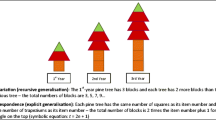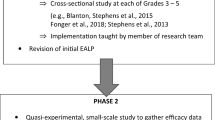Abstract
A common approach used for introducing algebra to young adolescents is an exploration of visual growth patterns and expressing these patterns as functions and algebraic expressions. Past research has indicated that many adolescents experience difficulties with this approach. This paper explores teaching actions and thinking that begins to bridge many of these difficulties at an early age. A teaching experiment was conducted with two classes of students with an average age of eight years and six months. From the results it appears that young students are capable not only of thinking about the relationship between two data sets, but also of expressing this relationship in a very abstract form.




Similar content being viewed by others
References
Arzarello, F. (1998). The role of natural language in prealgebraic and algebraic thinking. In H. Steinbring, M. Bussi, & A. Sierpinska (Eds.), Language and communication in the mathematics classroom (pp. 249–261). Reston: National Council of Teachers of Mathematics.
Bennett, A. (1988). Visual thinking and number relationships. Mathematics Teacher, 81(4), 267–272.
Blanton, M., & Kaput, J. (2004). Elementary grades students’ capacity for functional thinking. In M. J. Hoynes & A. B. Fuglestad (Eds.), Proceedings of the 28th Conference of the International Group for the Psychology of Mathematics Education (vol. 2, pp. 135–142). Oslo.
Carpenter, T. P., Franke, M. L., & Levi, L. W. (2003). Thinking mathematically: Integrating arithmetic and algebra in elementary school. Portsmouth: Heinemann.
Cobb, P. (2000). Conducting teaching experiments in collaboration with teachers. In A. Kelly & R. A. Lesh (Eds.), Handbook of research design in mathematics and science education (pp. 307–333). Mahwah: Erlbaum.
Cobb, P., Confrey, J., diSessa, A., Lehrer, R., & Schauble, L. (2003). Design experiments in educational research. Educational Researcher, 32(1), 9–13.
Confrey, J., & Lachance, A. (2000). Transformative teaching experiments through conjecture-drive research design. In A. Kelly & R. A. Lesh (Eds.), Handbook of research design in mathematics and science education (pp. 231–265). Mahwah: Erlbaum.
Ernest, P. (2002). A semiotic perspective of mathematical activity. Paper presented at PME 26 2002, Norwich.
Johnassen, D. H., Beissner, K., & Yacci, M. (1993). Structural knowledge: Techniques for representing, conveying, and acquiring structural knowledge. Hillsdale: Erlbaum.
Harel, G. (2001). The development of mathematical induction as a proof scheme: A model for DRN based instruction. In S. Campbell & R. Zaskis (Eds.), Learning and teaching number theory, journal of mathematical behavior (pp. 185–212). New Jersey: Albex.
Kaput, J., & Blanton, M. (2001). Algebrafying the elementary mathematics experience. In H. Chick, K. Stacey, J. Vincent, & J. Vincent (Eds.), The future of the teaching and learning of algebra. Proceedings of the 12th ICMI study conference (vol. 1, pp. 344–352). Melbourne: ICMI.
MacGregor, M., & Stacey, K. (1996). Origins of students’ interpretation of algebraic notation. In L. Puig & A. Gutierrez (Eds.), Proceedings of the 20th International Conference for Psychology of Mathematics Education (vol. 3, pp. 289–296). Valencia.
Malara, N., & Navarra, G. (2003). ArAl Project: Arithmetic pathways towards favouring pre-algebraic thinking. Bologna: Pitagora Editrice.
Otte, M. (2001). Mathematical expistemology from a semiotic point of view. Paper presented in the Discussion Group for Semiotics in Mathematics Education at PME 25, Utrecht.
Otte, M. (2006). Mathematical epistemology from a Peircean semiotic point of view. Educational Studies in Mathematics, 61, 11–38.
Peirce, C. S. (1960). Collected papers. Cambridge: Harvard University Press.
Piaget, J. (1970). Genetic epistemology. New York: Columbia University Press.
Presmeg, N. (1997). A semiotic framework for linking cultural practice and classroom mathematics. ERIC Document Reproduction Service No. Ed 425 257.
Radford, L. (2001). On the relevance of semiotics in mathematics education. Paper presented in the Discussion Group for Semiotics in Mathematics Education at PME 25, Utrecht.
Redden, T. (1996). “Wouldn’t it be good if we had a symbol to stand for any number”: The relationship between natural language and symbolic notation in pattern description. In L. Puig & A. Gutierrez (Eds.), Proceedings of the 20th International Conference, Psychology of Mathematics Education (vol. 4, pp. 195–202). Valencia.
Saenz-Ludlow, A. (2001). Classroom mathematics discourse as an evolving interpreting game. Paper presented in the Discussion Group for Semiotics in Mathematics Education at PME 25, Utrecht.
Saenz-Ludlow, A. (2006). Classroom interpreting games with an illustration. Educational Studies in Mathematics, 61(2), 183–218.
Sfard, A. (1991). On the dual nature of mathematical concepts: Reflections on processes and objects as different sides of the same coin. Educational Studies in Mathematics, 22(1), 191–228.
Stacey, K., & MacGregor, M. (1995). The effect of different approaches to algebra on students’ perceptions of functional relationships. Mathematics Education Research Journal, 7, 69–85.
Steffe, L. P., & Thompson, P. W. (2000). Teaching experiment methodology: Underlying principles and essential elements. In A. E. Kelly & R. A. Lesh (Eds.), Handbook of research design in mathematics and science education (pp. 267–306). Mahwah: Erlbaum.
Vygotsky, L. (1934/1986). Thought and language. Cambridge: MIT Press.
Warren, E. (1996). Interaction between instructional approaches, students’ reasoning processes, and their understanding of elementary algebra. Dissertation, Queensland University of Technology.
Warren, E. (2000). Visualisation and the development of early understanding in algebra. In T. Nakahara & M. Koyama (Ed.), Proceedings of the 24th conference of the International Group for the Psychology of Mathematics Education (vol. 4, pp. 273–280). Hiroshima.
Warren, E. (2006). Learning comparative mathematical language in the elementary school: A longitudinal study. Educational Studies in Mathematics, 62(2), 169–189.
Acknowledgement
This research is funded by a grant from the Australian Research Council (No. LP0348820)
Author information
Authors and Affiliations
Corresponding author
Rights and permissions
About this article
Cite this article
Warren, E., Cooper, T. Generalising the pattern rule for visual growth patterns: Actions that support 8 year olds’ thinking. Educ Stud Math 67, 171–185 (2008). https://doi.org/10.1007/s10649-007-9092-2
Received:
Accepted:
Published:
Issue Date:
DOI: https://doi.org/10.1007/s10649-007-9092-2




